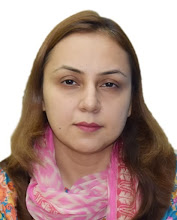Chapter 28: Designing for Inclusion - Exploring the POUR Principles
Date/Time: 17th Sep 2024 Wednesday , 2:34 am
It has been an interesting ride exploring the third module of the ISTEU online course "Designing for Inclusion ". Sharing key points from the module. Numerous times during the course I have wondered about how AI could be used to benefit the learners in the classroom that might be different or have difficulty in learning. These questions in this module made me think deeper. How could information be presented to them in a way that can be easily read, seen or heard? or how could information be presented to them in a way that can be understood easily? or how could information be presented to them that they could navigate easily without any difficulty. These questions are all related to the UDL representation principle.
The module also introduces the concept of "accessibility" - how to make information accessible to learners with difficulty. The module mentions "design for one - design for many" which means if we design for learners with variability, we might end up designing learning for all learners. The example of a YouTube video with captions is perfect , a deaf person can read the captions, and even a person who can listen also benefits from reading the captions - the language can be changed as well the font size of the captions can be increased.
Another interesting concept introduced in this module is POUR principles, which is also new for me. The POUR principles ensure that the information presented to the learners is accessible, which mean the learner can read, hear and see the information using various tools, the learner can understand the logical sequence of the information, the learner can easily navigate the information and the learner can do the task on different devices or platforms.
Summarising the way I understood it:
P - Perceivable - multiple means to see, hear and listen
For example Google Doc supports people with disabilities, if you click on tools, you will find voice typing, accessibility , translation of a document , spell check and grammar options. Any person can use the speech to type the document, the document can be translated in different languages, there is spell check and grammar option also available. Most importantly , in the accessibility feature you can turn on braille support, screen reader support and screen magnifier support. Flip grid and Screencast o matic can also be used to provide information in audio and video form and this will support learners with and without disability. Canva for education also has a vast variety of resources that can support all kinds of learners.
O - Operable - ease of navigation
In the Google doc, you could add a table of contents, with linked files. You could also create a hyper doc for your learners in Google doc. You could also use the Meyers 12 multimedia principles to ensure the information laid out on the page is easily understandable. You can use arrows to explain directions. You could have animated buttons to move to the next slide in Google Slides. Learners with difficulty in using a mouse could work with a keyboard and vice versa.
U - Understandable - can comprehend information easily - You could use the Meyers 12 multimedia principles to create slides that have an appropriate colour contrast, text and image alignment on slide, not over loaded with text, text to speech option available on the slides, using arrows to explain a process etc Graphic organisers in Canva for education can help present information in a way that is easily comprehensible. Various mind mapping tools online can also be used to present information in a way that can be understood easily using images, texts, links, arrows etc.
R - Robust - information can be accessed on different platforms and devices - the learner may be able to access the information on the laptop, desktop, ipad, tablet or a mobile. Seesaw and Purplemesh are two platforms that are platform independent. Both the learners and teachers can access information in multiple ways and create content in multiple ways that can be accessed by learners with or without disability. The content can be created in audio, video , text or can be drawn as well. The learner and the teacher can respond in either of the above forms. Both are exceptionally good platforms worth exploring. These platforms will support an inclusive learning environment in the classroom and schools.
To be honest, I think most of the schools are already using several edtech resources that provide support to learners with disabilities. Developing a deeper understanding of the UDL principles may help us as educators to focus on creating more effective learning experiences for all kinds of learners. And also knowing about the multiple identities of learners and having sufficient information about their funds of knowledge may help us as educators to design more impactful learning experiences for all learners. This is a lot to comprehend but without having an understanding of these concepts we may not be able to design for learners with disabilities.
Worth exploring a little more.
Enjoy Reading
Regards and prayers
Sheeba Ajmal

Comments
Post a Comment